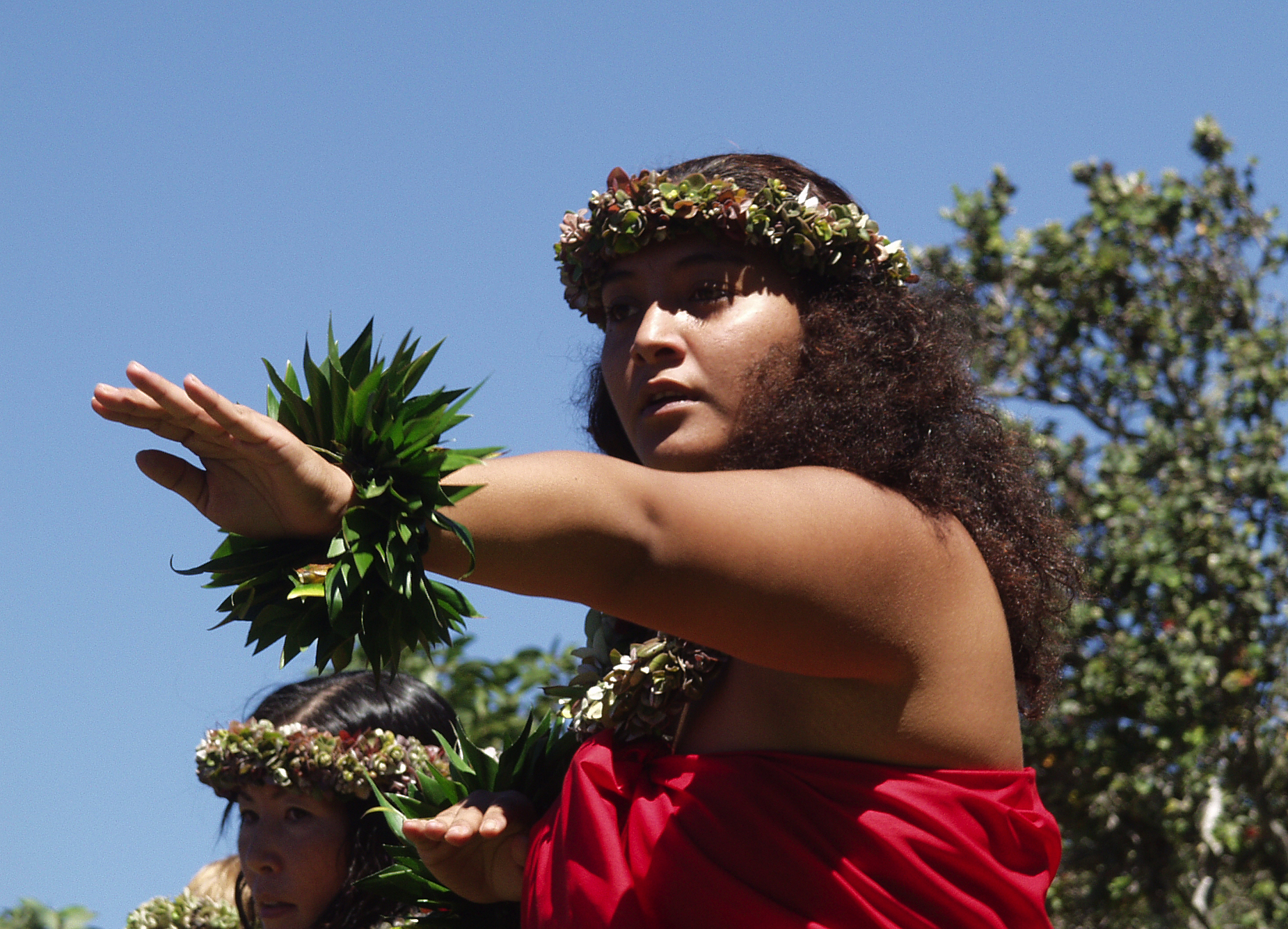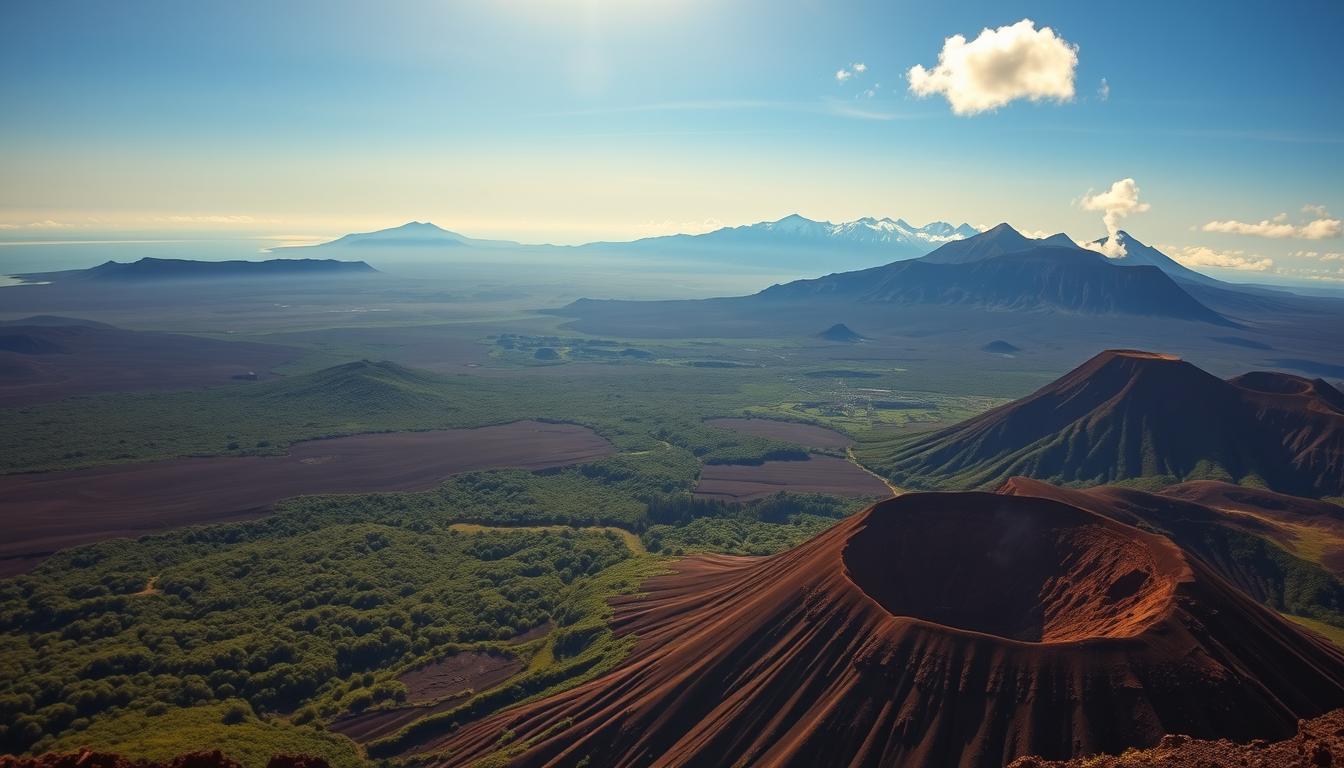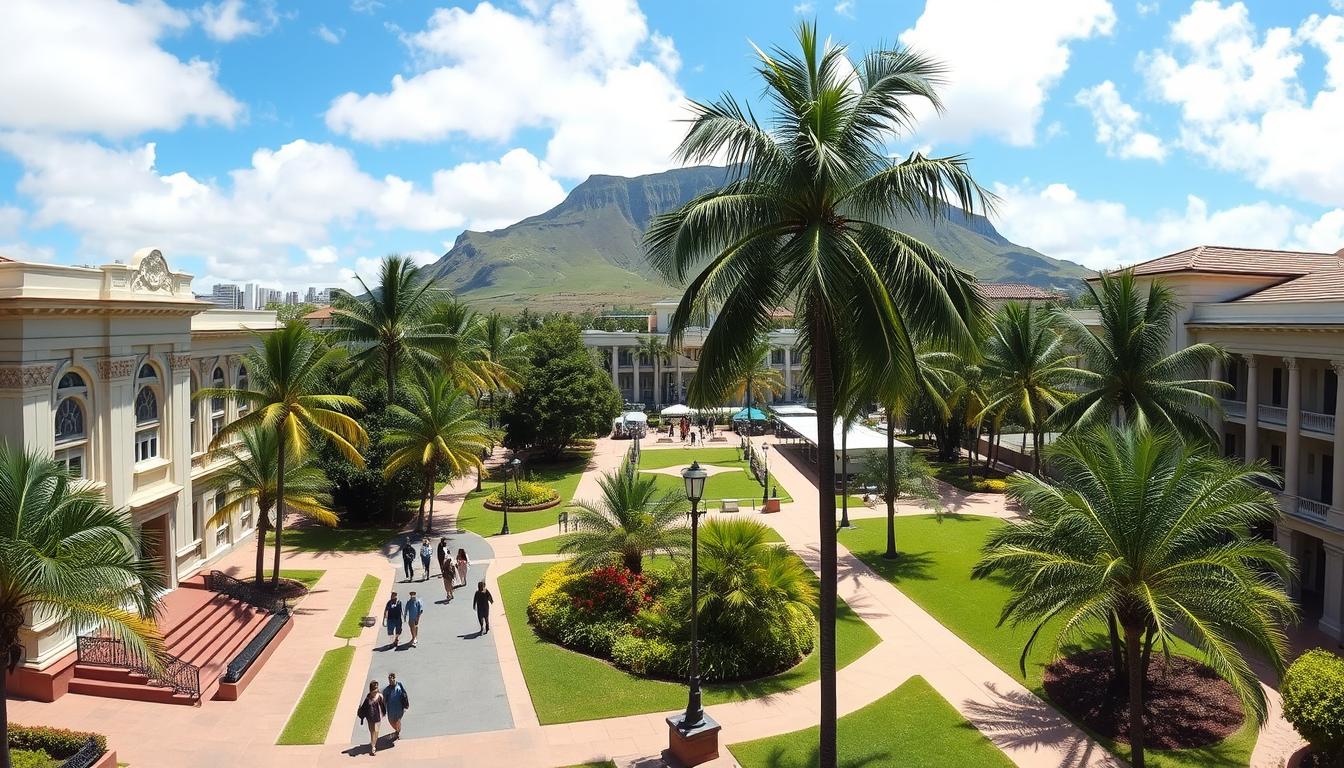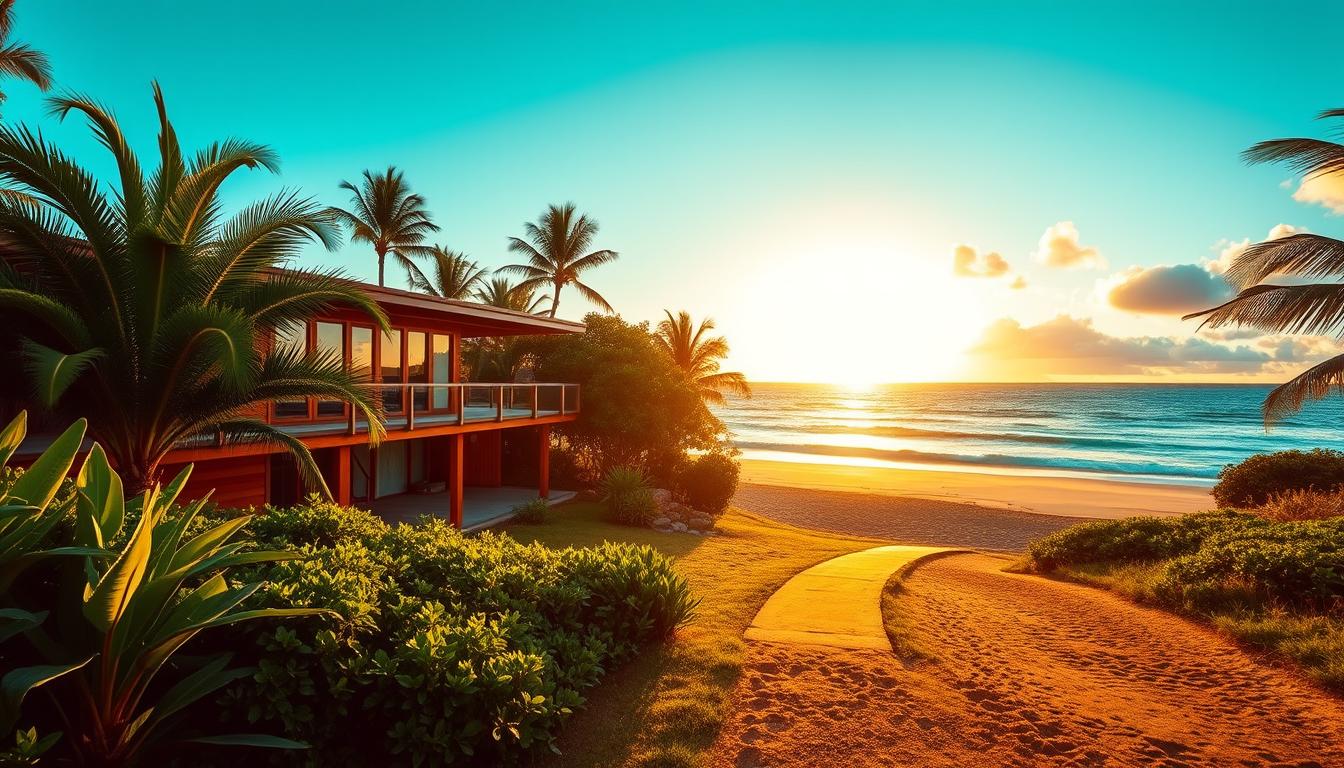Hawaii is known for its stunning beaches and natural beauty, but the islands also have a rich history waiting to be discovered. From ancient Hawaiian temples to World War II memorials, there are hidden historical sites in Hawaii that offer a glimpse into the past. In this article, we will explore some of these lesser-known sites, delving into their significance and the stories they hold. Whether you’re a history enthusiast or simply curious about Hawaii’s cultural heritage, these hidden historical sites are definitely worth a visit.
Key Takeaways:
- Hidden historical sites in Hawaii offer a unique insight into the state’s rich cultural heritage.
- Exploring these lesser-known sites is a chance to delve deeper into Hawaii’s history.
- From ancient Hawaiian temples to World War II memorials, these historical sites are diverse and fascinating.
- Visiting these hidden historical sites allows you to connect with the stories and significance of Hawaii’s past.
- Whether you’re a history enthusiast or simply curious, exploring these sites is a must-do when in Hawaii.
The Legacy of Pu’uhonua o Honaunau National Historical Park
Pu’uhonua o Honaunau National Historical Park is a significant historical site in Hawaii that offers a glimpse into ancient Hawaiian culture and traditions. The park is home to ancient Hawaiian temples, also known as heiaus, which were used for religious and political purposes. These temples hold great significance in Hawaiian history and are a testament to the spiritual beliefs of the ancient Hawaiians.
The park is also home to ancient Hawaiian aquaculture fishponds, which were used for raising fish and other aquatic life. These fishponds were an important food source for the ancient Hawaiians and played a crucial role in their society.
Additionally, the park features petroglyphs, which are ancient carvings in rock that depict Hawaiian deities and other important cultural symbols. These petroglyphs provide valuable insights into the beliefs and customs of the ancient Hawaiians.
Explore the legacy of Pu’uhonua o Honaunau National Historical Park to uncover the rich cultural heritage of Hawaii.
Insights into Pu’u O Mahuka Heiau: Oahu’s Hill of Escape
Pu’u O Mahuka Heiau is a significant historical site located on the island of Oahu. It is an ancient Hawaiian temple that dates back to the 17th century. The name Pu’u O Mahuka means “Hill of Escape” in the Hawaiian language, and it is believed to refer to the heiau’s use as a place of refuge during times of warfare. The temple is situated on a hill overlooking Waimea Bay and the surrounding countryside. It was dedicated to the war god Kuka’ilimoku and served as a place of worship, as well as a gathering place for chiefs and priests. Today, Pu’u O Mahuka Heiau is a designated National Historic Landmark and offers visitors a chance to learn about ancient Hawaiian culture and history.
Shangri La: A Blend of Hawaiian Culture and Islamic Art
Shangri La is a unique museum located in Honolulu that showcases the intersection of Hawaiian culture and Islamic art. The museum was the former home of American heiress and philanthropist Doris Duke, who had a passion for collecting art from the Islamic world. The museum’s collection includes ceramics, textiles, metalwork, jewelry, and furniture from various Islamic cultures spanning over 1,400 years.
One of the highlights of the collection is the historic Damascus Room, an 18th-century Syrian architecture and design. It was acquired by Doris Duke in the 1950s and features intricate wooden carvings, colorful tilework, and other decorative elements. Shangri La provides a fascinating insight into the cultural exchange between Hawaii and the Islamic world.
The Legacy of Doris Duke and Her Collection
Doris Duke’s passion for Islamic art led her to amass an impressive collection that reflects the artistic and cultural diversity of the Islamic world. Her collection not only showcases the beauty and craftsmanship of Islamic art but also serves as a testament to cross-cultural connections and appreciation. Doris Duke’s legacy is preserved in Shangri La, where visitors can experience the art and immerse themselves in the rich cultural heritage she so deeply valued.
Inside the Historic Damascus Room
The historic Damascus Room is a true gem within the Shangri La collection. This meticulously restored 18th-century Syrian room takes visitors on a journey through time, with its exquisite wooden panels and intricately painted tiles. The room’s design reflects the opulence and grandeur that characterized the homes of wealthy Damascene families during that period. Stepping inside the Damascus Room is like being transported to another era, where the artistry of the Islamic world unfolds before your eyes.
Mystique of Kalaupapa: The Exile of Hansen’s Disease Patients
Kalaupapa National Historical Park, located on the island of Molokai, is a place of great historical significance. The park commemorates the forced exile of over 8,000 people with Hansen’s disease, also known as leprosy, to the Kalaupapa Peninsula between 1866 and 1969. The patients were sent to live in isolation, separated from their families and friends. The park includes the Kalaupapa Settlement, where the patients were housed, as well as the historic village of Kalawao, where the first settlements were established. The park serves as a reminder of the human rights abuses that occurred and honors the resilience and strength of the patients who were forced to live there.
Aloha Tower: Hawaii’s Beacon of Welcome
Aloha Tower, located in Honolulu, is an iconic landmark that holds great historical significance for Hawaii. Built in 1926, this majestic tower served as both a lighthouse and a passenger terminal, welcoming thousands of travelers entering the Honolulu Harbor. Standing at an impressive height of 184 feet, Aloha Tower was the tallest building in Hawaii at the time.
The Maritime History of Aloha Tower
Aloha Tower played a pivotal role in Hawaii’s maritime history. As ships arrived from the mainland United States and various parts of the world, the tower would guide them to the harbor and serve as a beacon of welcome. Passengers on steamships would be greeted by the sight of Aloha Tower, symbolizing the warm spirit of hospitality that Hawaii is known for. This historic tower became a significant gateway to the islands, connecting visitors to the beauty and culture that awaited them.
Exploring Aloha Tower Marketplace Today
Today, Aloha Tower continues to captivate visitors as a popular tourist attraction. Adjacent to the tower, the Aloha Tower Marketplace offers an array of shops, restaurants, and entertainment options. Visitors can explore the marketplace, immerse themselves in the vibrant atmosphere, and enjoy the picturesque views of the ocean and harbor. The marketplace also provides an excellent opportunity to learn about the tower’s maritime history through exhibits and displays.
As you visit Aloha Tower and the surrounding marketplace, you’ll have the chance to experience a blend of history, culture, and modernity. The tower stands as a symbol of Hawaii’s warm welcome and rich maritime heritage, inviting you to explore and embrace the spirit of Aloha.
Hidden Historical Sites in Hawaii’s Roots
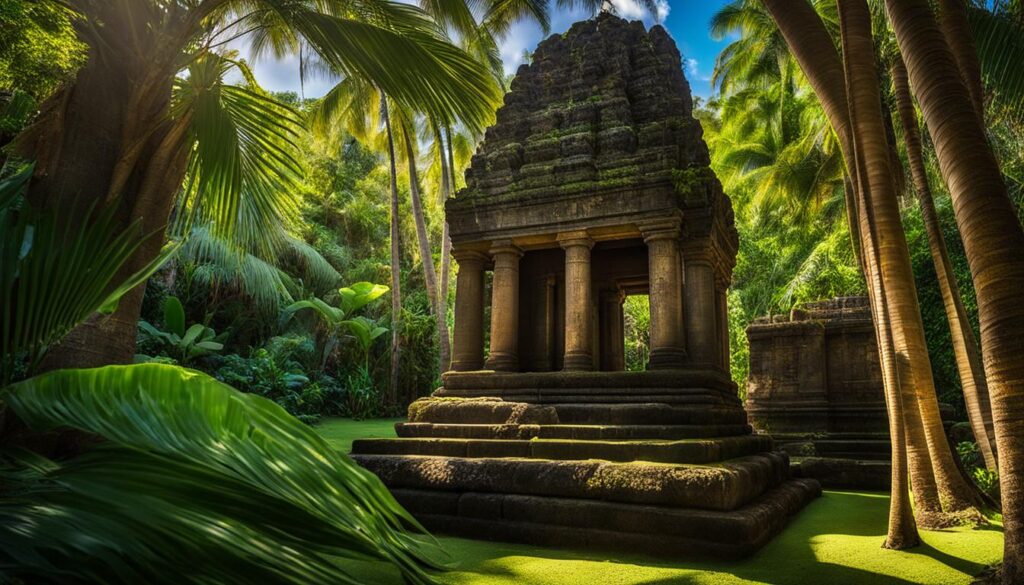
Hawaii is not just about its famous beaches and tourist attractions. The islands are also home to numerous hidden historical sites that showcase the rich cultural heritage of the state. These lesser-known sites offer a glimpse into the roots of Hawaii, from ancient Hawaiian temples and petroglyphs to colonial-era buildings and significant landmarks. Exploring these hidden historical sites is a chance to delve deeper into Hawaii’s history and gain a greater appreciation for its cultural diversity.
| Historical Site | Description |
|---|---|
| Ancient Hawaiian Temples | Explore the sacred heiaus, or temples, built by the ancient Hawaiians for religious and political purposes. These temples offer valuable insights into the spiritual beliefs and practices of the ancient Hawaiians. |
| Petroglyphs | Discover the ancient rock carvings known as petroglyphs, which depict Hawaiian deities and cultural symbols. These carvings provide a fascinating glimpse into the traditions and mythology of ancient Hawaii. |
| Colonial-Era Buildings | Uncover the architectural heritage of Hawaii through colonial-era buildings, including plantations, churches, and government structures. These buildings offer a window into Hawaii’s history during the time of Western influence. |
| Significant Landmarks | Visit lesser-known landmarks that hold historical and cultural significance, such as burial sites, battlefields, and monuments. These landmarks tell compelling stories of Hawaii’s past and its connections to the broader world. |
By exploring these hidden historical sites in Hawaii, visitors can gain a deeper understanding of the state’s cultural identity and appreciate the diverse influences that have shaped it over the centuries.
Punchbowl Cemetery: Honoring Heroes at National Memorial Cemetery of the Pacific
The Punchbowl Cemetery, officially known as the National Memorial Cemetery of the Pacific, is a solemn and significant historical site in Honolulu. The cemetery is located in the Punchbowl Crater and serves as the final resting place for thousands of American military personnel. It was established in 1948 to honor those who sacrificed their lives in World War II and subsequent conflicts.
The Punchbowl Cemetery features various monuments and memorials that tell the stories of these brave individuals and their sacrifices. These monuments and memorials serve as tangible reminders of the cost of freedom and the bravery of those who gave their lives to protect it.
Visiting the Punchbowl Cemetery is a chance to pay tribute to these heroes and reflect on their sacrifice. The serene and peaceful atmosphere of the cemetery provides an opportunity for quiet contemplation and remembrance. It is a place where visitors can honor the memory of those who fought for their country and express gratitude for the freedoms they enjoy today.
Diving into Hawaii Volcanoes National Park’s Past
Hawaii Volcanoes National Park is a unique and intriguing historical site that showcases the volcanic landscapes of the Hawaiian Islands. The park is home to two active volcanoes, Kilauea and Mauna Loa, which have shaped the landscape over millions of years. The volcanic activity in the park has not only created stunning landscapes but also holds great historical significance.
Volcanic Landscapes and Historical Significance
The volcanic landscapes of Hawaii Volcanoes National Park provide a glimpse into the powerful forces that have shaped the islands. Visitors can explore lava fields, volcanic craters, and other unique features that highlight the ongoing geological activity in the area. The park offers a chance to witness the dynamic nature of volcanoes and learn about their importance in Hawaiian culture. Volcanoes have played a significant role in shaping the land, creating fertile soil for agriculture, and influencing the traditional practices of the ancient Hawaiians.
Pipiwai Trail: A Path Through Ancient Hawaii
Within Hawaii Volcanoes National Park, the Pipiwai Trail offers a captivating journey through ancient Hawaii. This scenic trail takes visitors through a lush rainforest, crossing picturesque streams and leading to a breathtaking waterfall. Along the way, there are significant cultural sites that provide insights into the history and traditions of the ancient Hawaiians. The Pipiwai Trail offers a combination of natural beauty and historical significance, making it a must-visit destination within the park.
Unveiling the Royal History at Iolani Palace
Iolani Palace is an iconic historical site in Honolulu and the only royal palace on U.S. soil. Built in the 19th century, it served as the official residence of the Hawaiian monarchs until the overthrow of the Hawaiian Kingdom in 1893. Today, the palace is a National Historic Landmark and offers guided tours that provide insights into the opulence and grace of Hawaiian royalty.
Visitors can explore the grand halls of the palace, learn about its history, and admire the royal artifacts and furnishings. The palace showcases the unique architectural style of the time, blending both Western and traditional Hawaiian elements. The breathtakingly beautiful palace grounds also feature lavish gardens and statues that further enhance the regal atmosphere.
The guided tours offer a glimpse into the royal lifestyle, highlighting the ceremonial rooms, private quarters, and the throne room where the kings and queens of Hawaii held audiences and received dignitaries. The intricate details and exquisite craftsmanship of the palace’s interior transport visitors back in time, allowing them to experience firsthand the grandeur and elegance of Hawaiian royalty.
Unveiling the royal history at Iolani Palace is not only a journey into the past but also an opportunity to understand and appreciate the rich cultural heritage of Hawaii. The palace stands as a testament to the kingdom’s legacy and the resilience of its people.
Kona Coffee Living History Farm: A Taste of Local Heritage
The Kona Coffee Living History Farm is a must-visit destination for coffee enthusiasts and history buffs alike. Located in the picturesque hills of Hawaii’s Kona region, this unique historical site offers visitors an immersive farm-to-cup experience that showcases the rich heritage of coffee cultivation in Hawaii.
Interactive Experiencing of Coffee Cultivation
At the Kona Coffee Living History Farm, visitors have the opportunity to engage in interactive activities that provide a hands-on understanding of the coffee cultivation process. From planting and harvesting the coffee cherries to learning the traditional techniques of roasting and brewing, every step of the journey is covered.
A Journey through the Restored Farmstead
Step back in time as you explore the meticulously restored farmstead at the Kona Coffee Living History Farm. Wander through the lush coffee fields, explore the historic buildings, and gain insight into the traditional practices of coffee farming in Hawaii. You’ll learn about the meticulous care that goes into growing and processing Kona coffee, as well as the cultural significance of this beloved local crop.
Visiting the Kona Coffee Living History Farm is not just an educational experience; it’s a chance to immerse yourself in the flavors and aromas of Hawaii’s coffee heritage. With each sip of a freshly brewed cup of Kona coffee, you’ll taste the legacy of generations of farmers who have dedicated themselves to producing some of the world’s finest coffee beans.
Remember and Reflect: The Importance of Pearl Harbor
Pearl Harbor is one of the most significant historical sites in Hawaii and a place of remembrance and reflection. It serves as a reminder of the infamous attack that took place on December 7, 1941, when the Japanese launched a surprise military strike on the United States naval base. This devastating attack led to the entry of the United States into World War II. The events of that fateful day forever changed the course of history and had a profound impact on Hawaii and the world.
The USS Arizona Memorial: A Symbol of Sacrifice
One of the most poignant symbols of the Pearl Harbor attack is the USS Arizona Memorial. This solemn memorial stands over the sunken remains of the USS Arizona battleship, which became the final resting place for many brave servicemen who lost their lives during the attack. The memorial serves as a powerful reminder of the sacrifices made by those who gave their lives defending their country. Visitors can pay their respects, reflect on the tragedy, and honor the memory of the fallen.
Stepping onto the Battleship Missouri
Another significant historical site in Pearl Harbor is the Battleship Missouri, also known as the “Mighty Mo.” This battleship played a pivotal role in the Pacific Theater of World War II and was the site where the formal surrender of Japan took place, effectively ending the war. Stepping onto the deck of the Battleship Missouri allows visitors to walk in the footsteps of history and experience firsthand the magnitude of the events that unfolded on that fateful day. It is a remarkable opportunity to gain a deeper understanding of the sacrifices made by those who served.
Visiting Pearl Harbor offers a chance to remember the past, honor those who sacrificed their lives, and gain a deeper appreciation for the impact of World War II on Hawaii and the world. It is a place of solemnity and reflection, reminding us of the importance of preserving the memory of the past to guide our future.
Polynesian Cultural Center: Celebrating Pacific Island Heritage
The Polynesian Cultural Center is a vibrant and immersive historical site located on the island of Oahu, Hawaii. It is a celebration of the rich heritage of the Pacific Islands, showcasing the music, dance, arts, and traditions of various Polynesian cultures. Visitors to the Polynesian Cultural Center have the opportunity to explore authentic villages representing different Pacific Island nations, such as Hawaii, Samoa, Tahiti, and more.
At the Polynesian Cultural Center, guests can witness captivating cultural performances that highlight the unique traditions and talents of the Polynesian people. From mesmerizing hula dances to thrilling fire knife performances, the center offers a spectacular showcase of Pacific Island heritage.
In addition to watching performances, visitors can actively participate in hands-on activities that provide a deeper understanding of the diverse cultures. Learn how to make a lei, create traditional Polynesian crafts, or try your hand at traditional games.
A visit to the Polynesian Cultural Center is a chance to immerse yourself in the history and traditions of the Polynesian people. Experience the warm hospitality, vibrant colors, and captivating rhythms that define Pacific Island culture. Discover the beauty and significance of Polynesian art, music, and dance. Gain a greater appreciation for the rich heritage that is woven into the fabric of the islands of the Pacific.
Majestic Haleakala National Park’s Historical Journey
Haleakala National Park, located on the island of Maui, is an awe-inspiring historical site that offers visitors a glimpse into Hawaii’s rich natural and cultural heritage. The park is home to the magnificent Haleakala Crater, a dormant volcano that stands as a testament to the island’s volcanic origins. Witnessing the sunrise over the Haleakala Crater is a truly breathtaking experience, as the sky fills with vibrant hues, illuminating the ancient landscape below.
As the sun rises, it casts a golden glow over the expansive crater, creating a mesmerizing sight that captivates visitors from around the world. The Haleakala Crater is not only a geological wonder but also a spiritual and cultural symbol for the native Hawaiian people. It holds great significance in Hawaiian mythology and is considered a sacred place.
Exploring Haleakala National Park allows visitors to immerse themselves in the unique ecosystems of Hawaii. The park is home to a diverse range of native flora and fauna, including rare and endangered species that are found nowhere else on Earth. From vibrant wildflowers and rare birds to unique plant species adapted to the harsh volcanic environment, Haleakala National Park showcases the remarkable biodiversity of the Hawaiian Islands.
| Native Flora | Native Fauna |
|---|---|
| Hinahina (Silversword) | Nēnē (Hawaiian Goose) |
| Koa Tree | ‘I’iwi (Hawaiian Honeycreeper) |
| Maui Onion | Nuku – Pu’u ‘īli (Haleakala Flightless Weevil) |
Explorers can hike through lush rainforests, traverse rugged lava fields, and marvel at the unique geological formations that have been shaped by centuries of volcanic activity. The park offers various trails that cater to different levels of hiking expertise, allowing visitors to discover the wonders of Haleakala at their own pace.
Visiting Haleakala National Park is not only an opportunity to witness the raw beauty of Hawaii’s landscapes but also a chance to connect with its rich cultural heritage. The park serves as a living testament to the deep spiritual and ecological connection that the native Hawaiians have with their environment. It provides a unique window into the ancient past and offers a sense of tranquility and reverence that can only be found in this majestic natural setting.
Exploring the Spiritual Power of Pu’uloa Petroglyphs
The Pu’uloa Petroglyphs are a captivating historical site on the island of Hawaii that showcases ancient Hawaiian rock carvings. These petroglyphs, believed to have been created by the ancient Hawaiians thousands of years ago, hold great spiritual significance.
Carved into the volcanic rock, the Pu’uloa Petroglyphs depict a variety of symbols, including human figures, animals, and geometric patterns. Each symbol is thought to represent important cultural and religious beliefs of the ancient Hawaiians, serving as a connection to their spiritual world.
Exploring the Pu’uloa Petroglyphs allows visitors to immerse themselves in the spiritual power of these ancient artworks. It provides a unique opportunity to gain a deeper understanding of Hawaiian culture and history, as well as experience the rich spiritual heritage of the island.
Discovering the Royal Pu’uhonua O Hōnaunau
Pu’uhonua O Hōnaunau National Historical Park, also known as the City of Refuge, is a historical site on the island of Hawaii that provides insights into ancient Hawaiian culture and the importance of temple restorations. The park is home to ancient Hawaiian temples known as heiaus, which were places of worship and served as refuges for those seeking forgiveness or sanctuary. The restoration efforts at Pu’uhonua O Hōnaunau allow visitors to experience the temples as they were in ancient times, providing a glimpse into the spiritual practices and beliefs of the ancient Hawaiians. Discovering the royal Pu’uhonua O Hōnaunau is a journey into the past and a chance to appreciate the cultural heritage of Hawaii.
The Aloha and Festive Spirit of Hawaii’s Cultural Festivals
Hawaii is renowned for its vibrant cultural festivals that embody the spirit of Aloha and embrace the diverse heritage of the islands. Among these celebrations, the Merrie Monarch Festival and the Aloha Festivals stand out as iconic demonstrations of Hawaiian traditions and customs.
Merrie Monarch Festival: A Hula Extravaganza
The Merrie Monarch Festival is dedicated to showcasing hula, the ancient Hawaiian art form that combines dance, music, and storytelling. Held annually in Hilo on the Big Island, this festival captivates visitors and locals alike with mesmerizing performances, captivating competitions, and cultural exhibitions. Skilled hula dancers and talented musicians from across the islands gather to present their talents, honoring the traditions passed down through generations.
Aloha Festivals: A Statewide Celebration of Hawaiian Culture
The Aloha Festivals encompass a series of events that take place throughout the Hawaiian Islands, celebrating the rich cultural heritage of Hawaii and fostering a sense of unity. Spanning several weeks, the festivals include vibrant parades, lively concerts, and various cultural activities that highlight the diversity of Hawaiian music, dance, and arts. These festivities bring communities together, promote cultural preservation, and offer visitors a unique opportunity to immerse themselves in the vibrant traditions and warmth of Aloha.
Immerse yourself in the Aloha and festive spirit of Hawaii’s cultural festivals, such as the Merrie Monarch Festival and the Aloha Festivals. These celebrations serve as a powerful reminder of the rich cultural heritage that Hawaii holds and provide an unforgettable experience for visitors from around the world.
FAQ
What are some hidden historical sites in Hawaii worth exploring?
Some hidden historical sites in Hawaii worth exploring include Pu’uhonua o Honaunau National Historical Park, Pu’u O Mahuka Heiau, Shangri La, Kalaupapa National Historical Park, Aloha Tower, Hawaii Volcanoes National Park, Iolani Palace, Kona Coffee Living History Farm, Pearl Harbor, Polynesian Cultural Center, Haleakala National Park, the Pu’uloa Petroglyphs, Pu’uhonua O Hōnaunau National Historical Park, and the cultural festivals of Hawaii.
What is the significance of Pu’uhonua o Honaunau National Historical Park?
Pu’uhonua o Honaunau National Historical Park offers a glimpse into ancient Hawaiian culture and traditions. It is home to ancient Hawaiian temples called heiaus, which were used for religious and political purposes. The park also features aquaculture fishponds that were important food sources for the ancient Hawaiians. Additionally, there are petroglyphs that provide insights into Hawaiian beliefs and customs.
What is the history behind Pu’u O Mahuka Heiau on the island of Oahu?
Pu’u O Mahuka Heiau is an ancient Hawaiian temple that dates back to the 17th century. It served as a place of worship and a gathering place for chiefs and priests. The temple is dedicated to the war god Kuka’ilimoku and overlooks Waimea Bay. Today, it is a designated National Historic Landmark and offers visitors a chance to learn about ancient Hawaiian culture and history.
What can be found at Shangri La in Honolulu?
Shangri La is a unique museum that showcases the intersection of Hawaiian culture and Islamic art. The museum was the former home of Doris Duke, an American heiress and art collector. The collection includes ceramics, textiles, jewelry, and furniture from various Islamic cultures. One of the highlights is the historic Damascus Room, which features intricate wooden carvings and colorful tilework.
What is the historical significance of Kalaupapa National Historical Park on Molokai?
Kalaupapa National Historical Park commemorates the forced exile of over 8,000 people with Hansen’s disease to the Kalaupapa Peninsula between 1866 and 1969. The park includes the Kalaupapa Settlement where the patients were housed, as well as the historic village of Kalawao. It serves as a reminder of the human rights abuses that occurred and honors the resilience of the patients who were forced to live there.
What is the history behind Aloha Tower in Honolulu?
Aloha Tower served as a lighthouse and a passenger terminal for ships entering the Honolulu Harbor. Built in 1926, it was the tallest building in Hawaii at the time. It played a significant role in Hawaii’s maritime history, welcoming passengers arriving on steamships. Today, it is a popular tourist attraction and symbolizes Hawaii’s hospitality.
What can visitors discover at Hawaii Volcanoes National Park?
Hawaii Volcanoes National Park is home to two active volcanoes, Kilauea and Mauna Loa, which have shaped the landscape over millions of years. The park offers visitors the opportunity to explore volcanic formations and learn about the cultural and historical importance of the volcanoes to the ancient Hawaiians. The Pipiwai Trail within the park takes visitors on a journey through ancient Hawaii and offers breathtaking views.
What is the significance of Iolani Palace in Honolulu?
Iolani Palace is the only royal palace on U.S. soil and served as the official residence of the Hawaiian monarchs until the overthrow of the Hawaiian Kingdom in 1893. Today, it is a National Historic Landmark and offers guided tours that provide insights into the opulence and grace of Hawaiian royalty. Visitors can explore the grand halls, learn about its history, and admire the royal artifacts and furnishings.
What can visitors experience at Kona Coffee Living History Farm?
Kona Coffee Living History Farm provides an interactive experience of coffee cultivation. Located in the Kona region, visitors can learn about the process of coffee production, from planting and harvesting to roasting and brewing. The restored farmstead showcases the traditional practices of coffee farming in Hawaii and offers a glimpse into the history and culture of the Kona coffee industry.
What is the historical significance of Pearl Harbor?
Pearl Harbor is the site of the infamous attack by the Japanese on December 7, 1941, which led to the United States’ entry into World War II. The USS Arizona Memorial and the Battleship Missouri stand as symbols of the sacrifices made during the attack and the end of the war. Visiting Pearl Harbor allows visitors to pay their respects, learn about the events of that day, and gain a deeper understanding of its impact on Hawaii and the world.
What can visitors discover at the Polynesian Cultural Center?
The Polynesian Cultural Center celebrates the rich heritage of the Pacific Islands. Visitors can explore authentic villages, watch cultural performances, and participate in hands-on activities to gain a deeper appreciation for the diverse Polynesian cultures, including Hawaii, Samoa, and Tahiti.
What can visitors experience at Haleakala National Park?
Haleakala National Park is known for its stunning landscapes, including the Haleakala Crater, a dormant volcano. Witnessing the sunrise over the crater is a popular activity. The park is also home to a diverse range of native flora and fauna, allowing visitors to appreciate the natural beauty of Hawaii and learn about unique ecosystems.
What is the significance of the Pu’uloa Petroglyphs on the island of Hawaii?
The Pu’uloa Petroglyphs showcase ancient Hawaiian rock carvings that are believed to have been created thousands of years ago. The carvings depict various symbols representing important cultural and religious beliefs. Exploring the petroglyphs allows visitors to connect with the spiritual power of these ancient artworks and gain a deeper understanding of Hawaiian culture and history.
What is the history behind Pu’uhonua O Hōnaunau National Historical Park?
Pu’uhonua O Hōnaunau National Historical Park, also known as the City of Refuge, provides insights into ancient Hawaiian culture and the importance of temple restorations. The park is home to ancient Hawaiian temples or heiaus that served as places of worship and refuges for those seeking forgiveness or sanctuary. The restoration efforts allow visitors to experience the temples as they were in ancient times and appreciate the cultural heritage of Hawaii.
What are some cultural festivals in Hawaii worth attending?
Some cultural festivals in Hawaii worth attending include the Merrie Monarch Festival, which celebrates hula, and the Aloha Festivals, a statewide celebration of Hawaiian culture. These festivals bring communities together, promote cultural preservation, and provide a unique opportunity to immerse yourself in the rich traditions of Hawaii.

Scott Sweeney is the creator of Virtual Hawaii 360. Scott is a professional marketer and a lifelong Hawaii enthusiast. Scott splits time between Oahu and Dayton, Ohio. In addition to his marketing endevours, he is also a published Ukulele musician.

